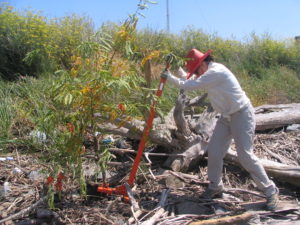What are Weed Management Areas (WMAs)?

Weed wrenching red sesbania. Photo courtesy Solano Resource Conservation District.
WMAs are local stakeholder collaborations focusing on invasive plant control efforts. They are most often coordinated by County Agricultural Commissioner (CAC) offices, but in some cases they are coordinated by Resource Conservation Districts (RCDs). All interested land management entities, public and private, are invited to participate. WMA partners work together to identify top strategic priorities, share updates on what they are seeing in the field, and coordinate multi-jurisdictional projects.
List of California Weed Management Areas
Accomplishments
California’s WMAs have proven to be an efficient and effective instrument for controlling the spread and impact of invasive weeds. A report published by the California Dept. of Food and Agriculture (CDFA) listed the following accomplishments over the previous five years:
- Permanent eradication of 2,015 populations of high-priority weed infestations
- Effective treatment of more than 128,421 acres of high-priority weed infestations
- Distribution of $5.6 million to 48 WMAs covering 58 counties
- Leveraging a 3-to-1 match from outside grant funding and in-kind services
- Development of new local partnerships between public agencies, private landowners, agricultural producers and conservationists
- Outreach programs reaching 88,000 people
How the Program Works
The program is defined in state code. Funding from the state budget is placed in the Noxious Weed Management Account administered by CDFA, who then gives grants to WMAs. To receive funding, WMAs must have an MOU between all stakeholder groups in their area and a strategic plan defining their goals and objectives. Many diverse entities participate in WMAs, including:
- Private partners – utilities, land trusts, forest industry, pest control operators, ranchers, farmers, nurseries
- County agencies – Agricultural Commissioners, Resource Conservation Districts, parks departments, public works departments, school districts, municipalities
- State agencies – State Parks, Caltrans, University of California Cooperative Extension, Calfire, Dept. of Fish and Wildlife, Department of Water Resources
- Federal agencies – US Forest Service, National Park Service, Bureau of Land Management, US Fish and Wildlife Service, US Army Corps of Engineers
- Nonprofit organizations – California Farm Bureau Federation, UC Master Gardeners, California Native Plant Society
State Legislative Background
California’s Weed Management Area (WMA) program, including the dedicated Noxious Weed Management Account, was created by AB 1168 (Frusetta) in 1999. In 2000, SB 1740 (Leslie) further defined the program and added $5 million to the account.
When these funds had been exhausted, Cal-IPC led a successful effort to secure new funding – $1.5 million/year was added in 2006 through AB 2479 (Cogdill).
In 2011 the budget crisis resulted in all state funding for the program being eliminated. In 2014, Cal-IPC worked to pass AB 2402 (Buchanan) which updated the code defining the program, but was unsuccessful in renewing funding.
In 2018, Cal-IPC worked with Assembly Members Tim Grayson and Lorena Gonzalez to pass AB 2470, which codified the state’s interagency Invasive Species Council and provided a platform for a budget request that secured $2 million in funding for WMAs.
In the 2019-2020 budget, $3 million was added to CDFA’s budget for the WMA program as part of the state’s new Biodiversity Initiative. Unfortunately, budget challenges resulting from Covid-19 resulted in this funding being removed.
In 2021, Cal-IPC continues to work to renew funding to the program. Meanwhile, new funding from unclaimed gas tax revenues is providing an alternate source of funding to County Agricultural Commissioner for work on CDFA-rated weeds.
Federal Funding
The Noxious Weed Control and Eradication Act of 2004, P.L. 108-412, created a program for USDA to fund WMAs through the states. It was envisioned as a $100 million/year program, and Cal-IPC joined others from across the country in advocating for it. However, funding was not appropriated by Congress then or at any time since. Cal-IPC continues to coordinate with partners nationally to look for openings to renew the effort for federal WMA funding.
